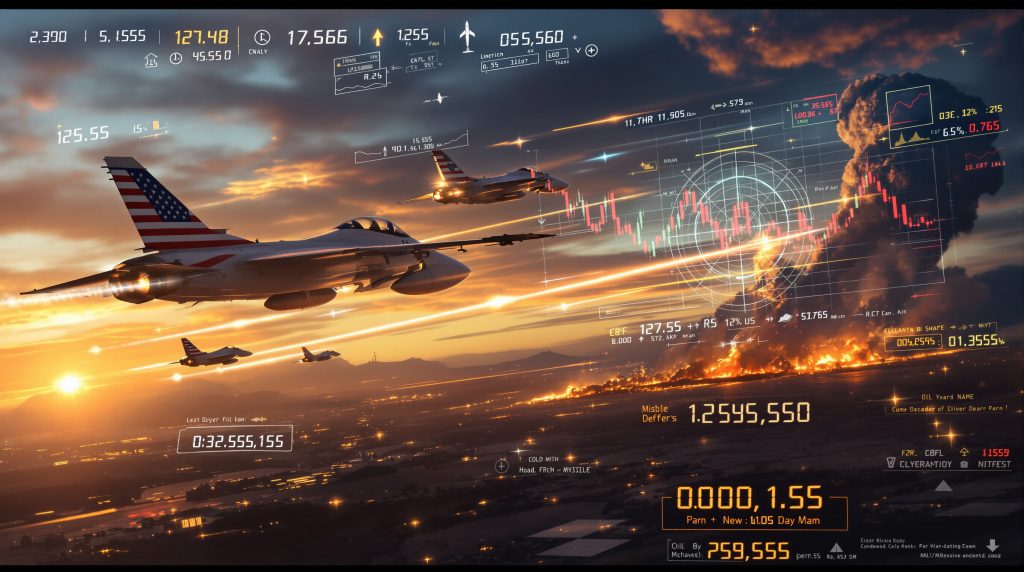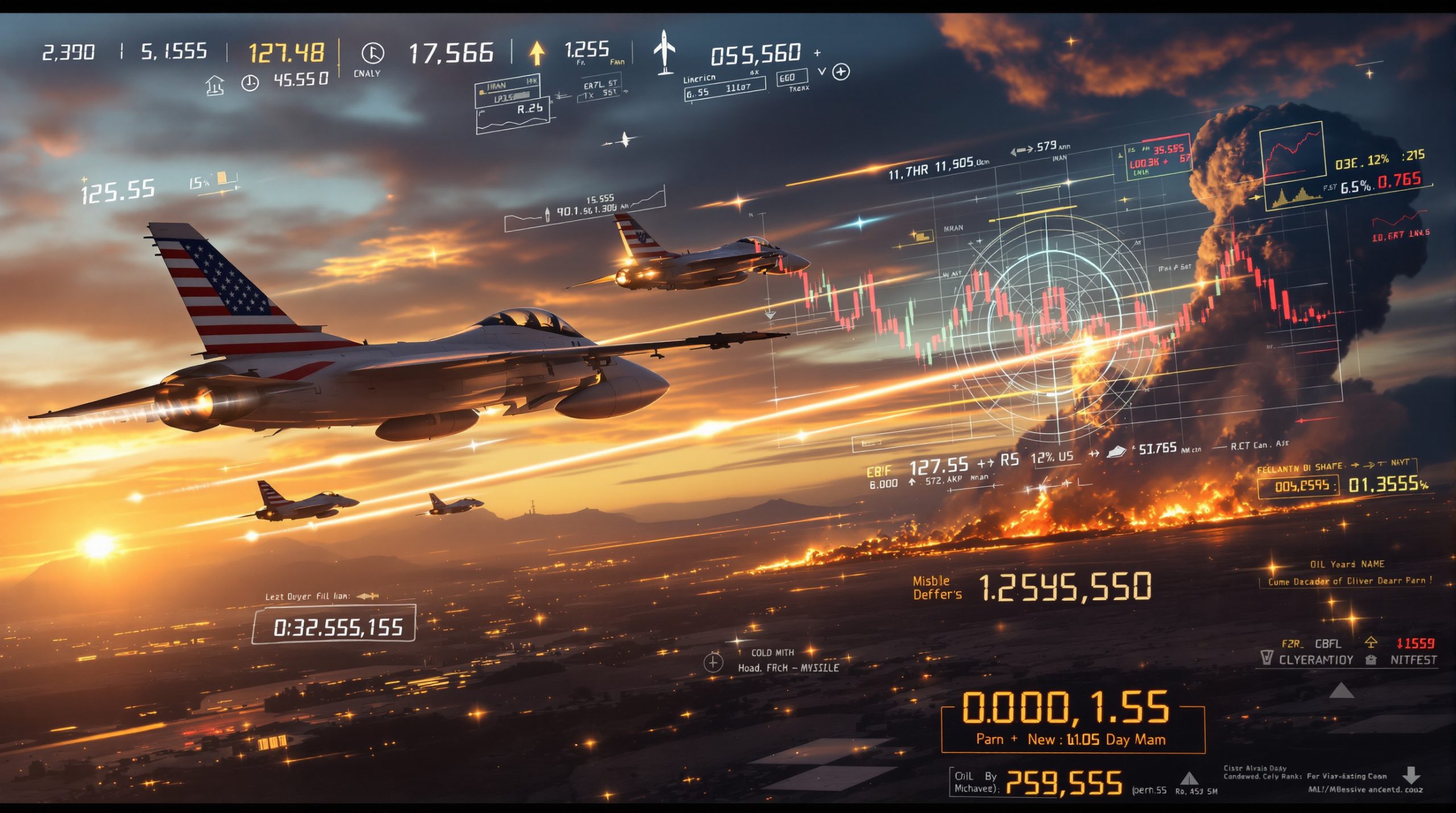US-Israel Joint Strike on Iran: Geopolitical Analysis and Global Implications
The geopolitical landscape faces potential transformation as tensions between the United States, Israel, and Iran reach critical levels. Strategic analysts are closely monitoring developments that suggest preparations for potential military action against Iran, which would have far-reaching consequences for global security, energy markets, and international alliances.
This analysis examines the complex factors driving this US and Israel joint strike on Iran, the potential operational considerations, and the wide-ranging implications should such a conflict materialize.
What Factors Are Driving US-Israel Strategic Calculations Regarding Iran?
The strategic relationship between the United States and Israel regarding Iran stems from a complex interplay of regional ambitions, security concerns, and geopolitical objectives that have evolved over decades.
For Israel, Iran represents what they consider an existential security challenge through several vectors:
- Iran's nuclear program development, which Israel views as an unacceptable threat
- Tehran's financial and military support for groups like Hezbollah, Hamas, and other proxies
- Iran's explicit statements challenging Israel's legitimacy
- Competition for regional influence and strategic dominance
From the American perspective, strategic interests include:
- Maintaining regional stability and protecting energy resources
- Supporting Israel as a key regional ally
- Countering Iran's growing influence in Iraq, Syria, Lebanon, and Yemen
- Preventing nuclear proliferation in the Middle East
- Securing maritime shipping routes through the Strait of Hormuz
Regional security experts note that both nations have grown increasingly aligned in their strategic objectives, despite occasional tactical differences in approach.
Historical Context of Escalating Tensions
The current tensions didn't materialize overnight but represent the culmination of decades of hostility and strategic rivalry:
1979: Iranian Revolution and hostage crisis severed US-Iran relations
1980s: Israel began viewing Iran as a strategic threat following the Iran-Iraq War
1990s: Emergence of Iran's nuclear program raised international concerns
2002-2015: Revelations about undeclared nuclear facilities increased tensions
2015: JCPOA (Iran nuclear deal) temporarily eased concerns
2018: US withdrawal from JCPOA reignited tensions
2020-present: Series of cyber attacks, assassinations, and proxy conflicts
According to strategic analysts, this long-standing mutual hostility has created a situation where both Washington and Jerusalem view containment strategies as increasingly insufficient for addressing what they perceive as Iran's destabilizing regional activities. The US-China Trade War Impact has further complicated the geopolitical calculations in the region.
What Would a Joint Military Operation Against Iran Entail?
Any coordinated military action against Iran would represent an extraordinarily complex operational undertaking, combining intelligence gathering, precision targeting, and multi-domain warfare capabilities from both nations.
Strategic Planning and Military Coordination
Military experts identify several key operational components that would likely feature in any joint US-Israel strike plan:
- Intelligence sharing: Pooling reconnaissance assets, satellite imagery, and human intelligence networks
- Electronic warfare coordination: Synchronizing efforts to neutralize Iranian air defenses and command systems
- Air refueling operations: Deployment of tanker aircraft to extend combat radius for strike aircraft
- Search and rescue capabilities: Positioning of recovery assets for downed pilots
- Naval assets: Positioning of carrier strike groups and missile defense vessels
- Cyber operations: Synchronized digital attacks on critical infrastructure and military networks
The operational complexity would be heightened by Iran's geography, with many high-value targets located deep within Iranian territory, often in hardened or underground facilities designed to withstand conventional attacks.
Target Selection and Strike Considerations
Military analysts suggest any coordinated action would likely prioritize several categories of targets:
| Target Category | Strategic Objective | Operational Challenges |
|---|---|---|
| Nuclear facilities | Degrading enrichment capacity | Hardened/underground construction |
| Air defense systems | Establishing air corridors | Integrated defense network |
| Command centers | Disrupting military response | Often redundant and dispersed |
| Missile capabilities | Limiting retaliatory strikes | Mobile launchers difficult to locate |
| Naval assets | Protecting maritime shipping | Risk of Strait of Hormuz closure |
Former military planners note that significant disagreements could emerge between US and Israeli strategists regarding target prioritization, with Israel likely to focus more heavily on Iran's nuclear infrastructure while American commanders might prioritize air defense and command nodes.
What Regional Response Could Follow Military Action?
Any military strike against Iran would trigger a complex cascade of regional reactions, potentially reshaping Middle Eastern geopolitics for decades.
Iranian Response Capabilities
Iran has developed a sophisticated multi-layered deterrence strategy that includes several retaliatory options:
- Ballistic missile strikes against US regional bases in Qatar, UAE, Kuwait, and other Gulf states
- Activation of proxy forces including Hezbollah in Lebanon, various Iraqi militias, Houthi forces in Yemen, and cells within Syria
- Maritime warfare targeting shipping through the Strait of Hormuz, potentially including mining operations
- Cyber attacks against critical infrastructure in both the US and Israel
- Mobilization of sleeper cells for attacks against Western interests globally
Regional security experts emphasize that Iran has spent decades preparing for precisely this scenario, developing asymmetric capabilities specifically designed to impose costs on adversaries without requiring conventional military superiority.
Impact on Regional States
The regional fallout would force every Middle Eastern nation to make difficult strategic calculations:
- Saudi Arabia and Gulf states: Would face immediate security threats while balancing their public opposition to Iran with their desire to avoid direct conflict
- Turkey: Would likely condemn military action while seeking to protect its economic interests with Iran
- Iraq: Would face intense internal pressure from pro-Iranian militias while attempting to maintain relations with the US
- Egypt and Jordan: Would manage domestic discontent over perceived Western aggression while maintaining their peace treaties with Israel
- Lebanon: Would face potential devastation if Hezbollah launches large-scale rocket attacks against Israel
Defense analysts suggest the regional repercussions could persist for years or even decades, potentially derailing nascent normalization efforts between Israel and Arab states while creating new security challenges throughout the region.
How Would Global Powers Respond?
Any military action against Iran would immediately transform from a regional conflict into a global geopolitical crisis, forcing major powers to take positions that could reshape international relations.
Russia and China's Strategic Calculations
Both Moscow and Beijing would likely view a US-Israel military operation as an opportunity to advance their strategic interests while undermining Western influence:
- Military support: Potential provision of intelligence, air defense systems, and technical assistance to Iran
- Diplomatic maneuvering: Using their UN Security Council positions to condemn the strikes and isolate the US
- Economic lifelines: Expanding trade relationships and financial channels to help Iran weather sanctions
- Information operations: Amplifying narratives about Western aggression and hypocrisy
Defense specialists note that both nations would carefully calibrate their responses to avoid direct military confrontation with the US while maximizing strategic advantages. For China in particular, ensuring continued energy flows would be a critical concern.
Beijing has worked diligently to strengthen economic ties with Iran through major infrastructure investments under its Belt and Road Initiative, potentially committing over $400 billion in long-term investments according to some estimates. This economic relationship gives China significant motivation to preserve Iranian stability.
European Response Dynamics
The European reaction would likely expose significant fractures within the Western alliance:
- UK: Would likely provide qualified support for military action while urging restraint
- France and Germany: Would likely express serious concerns about escalation while pushing for renewed diplomatic efforts
- Southern European nations: Would worry about refugee flows and energy security
- Eastern European states: Would balance support for US security guarantees against Russia with concerns about Middle Eastern stability
Foreign policy experts suggest these divisions could have lasting implications for NATO cohesion and transatlantic relations, potentially accelerating European strategic autonomy efforts.
What Economic Implications Would Follow?
The economic consequences of military action against Iran would ripple throughout the global economy, affecting everything from energy prices to supply chains and financial markets.
Energy Market Disruptions
Energy market analysts identify several immediate impacts that would likely follow military strikes:
- Oil price spike: Initial price jumps of 15-30% would be likely as markets price in supply disruption risks
- Strategic reserve deployment: Major economies would likely release emergency petroleum reserves
- Production increases: Saudi Arabia and other producers would face pressure to increase output
- Insurance premium surges: Shipping costs through the Persian Gulf would rise dramatically
- Natural gas impacts: European markets could see price increases if Qatar's exports are disrupted
Historical precedent suggests oil price movements would persist for months, with prices gradually moderating as alternative supply routes are established and risk premiums adjust to new realities.
Financial Market Reactions
Market strategists anticipate several key financial market responses:
| Asset Class | Expected Initial Reaction | Medium-Term Outlook |
|---|---|---|
| Gold | Sharp rally (8-15%) | Continued strength as geopolitical premium persists |
| US Dollar | Initial strengthening | Potential weakening against commodity currencies |
| Defense equities | Significant gains (10-20%) | Sustained uptrend as military budgets increase |
| Emerging markets | Selective selling pressure | Divergent performance based on energy exposure |
| Global bonds | Flight to quality | Yield curve steepening as inflation concerns emerge |
Economic historians note that similar geopolitical shocks have typically produced short-term market dislocations followed by normalization, though the interconnected nature of today's global economy creates more potential for cascading effects.
How Might Global Alliances Be Reshaped?
Military action against Iran could accelerate already emerging trends toward a more multipolar world order, with lasting implications for international institutions and alliances.
BRICS Expansion and De-dollarization Efforts
Analysts of international monetary systems suggest a military strike could accelerate several trends already underway within the BRICS alliance:
- Currency arrangements: Acceleration of settlement mechanisms that bypass the US dollar
- Gold accumulation: Increased central bank purchases of gold as a dollar alternative
- Strategic partnerships: Deepening military and energy cooperation among non-aligned nations
- Alternative financial systems: Expansion of payment mechanisms outside SWIFT
Financial experts note that these efforts have been gaining momentum since 2010, with China and Russia establishing gold-based trade settlement mechanisms that allow nations to conduct international trade without dollar exposure. The Shanghai Gold Exchange has already begun establishing vaults in BRICS member countries, with facilities in Hong Kong and Saudi Arabia representing early steps toward a more gold-centered trade system among these nations.
Middle Eastern Geopolitical Realignment
Regional specialists anticipate several potential shifts in Middle Eastern alignment patterns:
- Saudi Arabia: Accelerated diversification of security relationships beyond exclusive US reliance
- UAE and Qatar: Enhanced hedging strategies balancing relations with Western and Eastern powers
- Turkey: Strengthened independent regional posture leveraging both NATO membership and ties with Russia
- Egypt: Careful balancing act between Western financial support and growing BRICS influence
These shifts would reflect a broader trend toward strategic autonomy and multipolarity in a region traditionally dominated by US influence.
What Long-Term Strategic Implications Could Emerge?
Beyond immediate consequences, military action against Iran could reshape fundamental aspects of international relations, military doctrine, and global security frameworks.
Military Technology and Warfare Evolution
Defense analysts suggest several potential long-term military developments:
- Air defense innovation: Accelerated development of counter-stealth and electronic warfare capabilities
- Asymmetric warfare doctrine: Evolution of non-state actor tactics and technologies
- Cyber warfare integration: Greater blending of digital and kinetic operations
- Nuclear security rethinking: Reassessment of nuclear deterrence and non-proliferation frameworks
These developments would influence military procurement, alliance structures, and strategic planning across multiple regions for years to come. Additionally, the importance of critical minerals & energy security would become even more pronounced in this evolving landscape.
Global Security Architecture Transformation
International relations specialists identify several potential structural changes to global security frameworks:
- Nuclear proliferation pressures: Increased incentives for regional powers to pursue nuclear weapons as deterrents
- Collective security mechanisms: Weakening of international institutions like the UN in conflict prevention
- Regional security blocs: Acceleration of competing alliance structures beyond traditional Western frameworks
- Military modernization: Increased defense spending across multiple regions in response to heightened threat perceptions
These structural shifts would represent a fundamental challenge to the post-Cold War security order, potentially accelerating the transition toward a more fragmented international system with competing centers of power and influence.
How Are Precious Metals Markets Responding?
The precious metals sector has demonstrated notable sensitivity to escalating Middle Eastern tensions, with both investment and central bank behavior showing significant shifts in recent months.
Gold's Strategic Importance
Gold market specialists highlight several key dynamics currently driving the metal's performance:
- Record-breaking central bank purchases, with official sector buying exceeding 1,000 metric tons annually
- Accelerating de-dollarization efforts among non-Western economies
- Integration of gold into alternative payment mechanisms being developed by BRICS nations
- Increased recognition of gold as both a geopolitical hedge and inflation protection
Financial analysts note that gold's role is evolving beyond traditional safe-haven status to become an integral component of emerging alternative monetary frameworks. Recent gold prices analysis indicates this represents a potential structural shift in gold's position within the global financial architecture.
The Shanghai Gold Exchange's initiative to establish gold vaults in BRICS member countries represents a particularly significant development. By enabling nations like Saudi Arabia to convert trade surpluses into physical gold held within their own borders, this system creates a practical alternative to dollar reserves while addressing longstanding sovereign risk concerns.
Silver and Platinum Group Metals
The broader precious metals complex shows varying degrees of sensitivity to geopolitical developments:
- Silver: Demonstrates hybrid behavior, responding to both industrial demand concerns and monetary safe-haven flows
- Platinum: More heavily influenced by industrial applications, particularly automotive demand
- Palladium: Highly sensitive to potential disruptions of Russian supply, which accounts for approximately 40% of global production
Metals analysts emphasize that while gold tends to receive the most attention during geopolitical crises, the entire precious metals complex provides insights into market expectations regarding both monetary stability and industrial activity.
What Global Security Transformations Might Follow?
The potential for military action against Iran exists within a broader context of evolving global security dynamics that could reshape international relations for decades.
Nuclear Proliferation Concerns
Security specialists identify several potential nuclear-related developments:
- Regional nuclear ambitions: Increased incentives for other Middle Eastern states to pursue nuclear capabilities
- Non-proliferation regime weakening: Further erosion of international agreements limiting nuclear weapons spread
- Nuclear security doctrines: Evolution of first-strike and counter-force strategies
- Civilian nuclear energy reconsideration: Reassessment of nuclear power development plans in unstable regions
These developments would present profound challenges to existing non-proliferation frameworks already under strain from developments in North Korea and elsewhere. According to detailed analysis by the Arms Control Association, the consequences could be far-reaching.
Collective Security Mechanism Transformation
International organizations experts highlight several institutional challenges:
- United Nations effectiveness: Further marginalization of UN conflict prevention capabilities
- Regional security arrangements: Acceleration of competing security frameworks outside Western control
- Great power competition: Intensified rivalry between established and emerging powers
- Non-state actor influence: Increased prominence of transnational groups and proxy forces
These institutional shifts reflect broader questions about the viability of post-WWII international organizations in an increasingly multipolar world where consensus among major powers has become increasingly difficult to achieve. Moreover, markets like uranium market volatility could see significant changes due to these geopolitical shifts.
Conclusion: Navigating an Uncertain Future
The potential for US and Israel joint strike on Iran represents more than just another Middle Eastern conflict—it could mark a decisive turning point in global affairs with far-reaching consequences for international security, economic relationships, and alliance structures.
What seems increasingly clear is that the world stands at a crossroads between competing visions of international order: one built around established Western-led institutions and another emerging from new configurations of power championed by China, Russia, and their partners.
For policymakers, investors, and citizens worldwide, navigating this uncertain landscape will require careful analysis of rapidly evolving events while preparing for multiple potential futures in a world where longstanding assumptions about international relations no longer necessarily apply.
The coming months may determine whether escalating tensions lead to military confrontation, renewed diplomatic engagement, or an uneasy new equilibrium—with profound implications for global stability regardless of which path ultimately unfolds.
Ready to Stay Ahead of Global Market Movements?
Discover how geopolitical developments like US-Israel tensions with Iran can impact your investment portfolio by visiting Discovery Alert's proprietary Discovery IQ model at https://discoveryalert.com.au/, which turns complex global events into actionable investment insights to help position you ahead of market movements.




